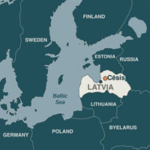Autor: Ilze Siliņa
Quelle & Copyright: Archive of the Āraiši Lake Fortress Foundation
When did human settlement begin in the Cēsis area, and who were the earliest settlers?
It is not known exactly when human habitation began in the Cēsis area. The process of settlement began in the Mesolithic (7,600–4,500 BC) and continued in the Neolithic (4,500–1,500 BC). These people were still hunter-fishers, as indicated by the bone harpoons found by the Rivers Amata and Rauna, not far from Āraiši, dated to the 7th–5th and 3rd millennium BC. In ethnic terms, these people may have been the same original settlers, or Lapponoid and Finno-Ugric immigrants, who inhabited northern Latvia in the Stone Age. At the end of the Neolithic, Indo-European groups entered the area, regarded as the ancestors of the Baltic tribes. The beginnings of agriculture and stock-keeping are regarded as being connected with these people.
Read more:
Jānis Apals. Arheoloģiskie pieminekļi Gaujas nacionālajā parkā. Rīga. 1986. 34.–35. lpp.
Jānis Apals, Āraiši Lake Fortress (LV)
Kad un kas sāka apdzīvot Cēsu novadu?
Cēsu novada apdzīvotības sākums precīzi nav zināms. Zemes apgūšanas process sākās mezolītā (7.600.–4.500. g.pr.Kr.) un turpinājās neolītā (4.500.–1.500. g.pr.Kr.). Tie joprojām bija mednieki un zvejnieki, kā to apliecina netālu no Āraišiem tekošo Amatas un Raunas upju krastos atrastās kaula harpūnas, kas datējamas attiecīgi ar 7.–5. un 3. g.t.pr.Kr. Etniskā ziņā tie varēja piederēt gan pirmatnācējiem, gan laponoīdu un somugru climes ieceļotāju grupām, kas akmens laikmetā apdzīvoja Latvijas ziemeļdaļu. Neolīta beigās novadā ieplūda indoieropiešu grupas, kuras uzskata par baltu cilšu priekštečiem. Ar viņiem saista zemkopības un lopkopības sākumus.
Plašāk:
Jānis Apals. Arheoloģiskie pieminekļi Gaujas nacionālajā parkā. Rīga. 1986. 34.–35. lpp.
Jānis Apals, Āraiši Lake Fortress (LV)








